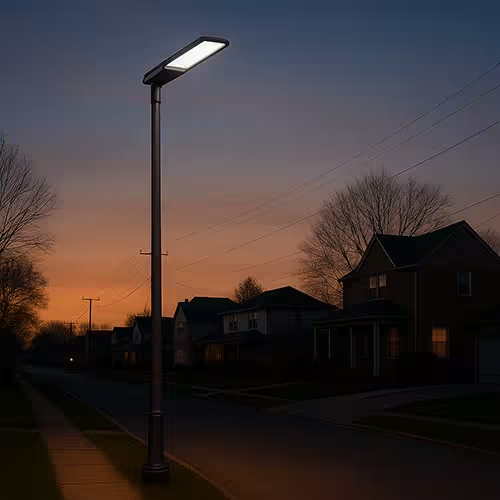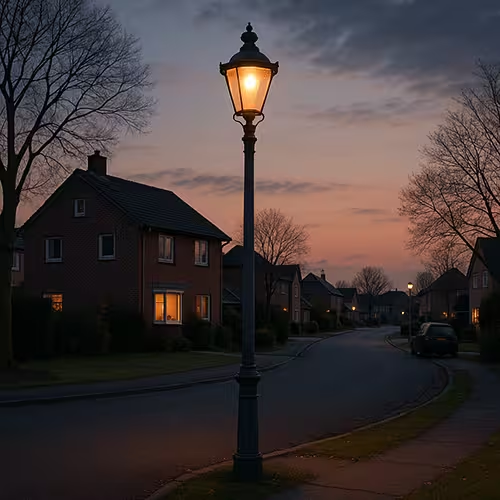By luminaire type
3 Article
 LED outdoor light, street lamp, IP65, Slim, grey, H 43.4cmDelivery 2-3 days
LED outdoor light, street lamp, IP65, Slim, grey, H 43.4cmDelivery 2-3 days LED street light outdoor lamp, gray, cold white, IP65 30WDelivery 2-3 days
LED street light outdoor lamp, gray, cold white, IP65 30WDelivery 2-3 days LED outdoor light street lamp, neutral white IP65 100 WDelivery 2-3 days
LED outdoor light street lamp, neutral white IP65 100 WDelivery 2-3 days
Street lights - safety and efficiency
Street lighting affects us all - whether on foot, by bike or in the car. Safety, orientation and well-being in public spaces depend heavily on how well streets and paths are illuminated. This is precisely where LED street lights come in. They combine state-of-the-art lighting technology with high efficiency and long-lasting quality. Anyone looking for a lighting solution for roads, car parks or driveways will find LED street lights to be a well thought-out, sustainable solution.

What is street lighting?
Street lighting describes luminaires that have been specially developed to illuminate public or private paths, roads, car parks or industrial areas - preferably with LED technology instead of conventional light sources.
LED stands for "Light Emitting Diode" - a light-emitting diode that converts electrical current into light. In contrast to outdated technologies such as sodium vapour lamps or mercury vapour lamps, LEDs produce bright light immediately, without a warm-up phase.
Typical features of street lights:
- Sturdy die-cast aluminium housing
- High-quality lens optics for targeted light distribution
- Impact and weatherproof construction (usually IP65/IP66)
- Can be dimmed or controlled via twilight sensor
Advantages of LED street lights
Street lights have long since overtaken classic street lamps. Why? The advantages speak for themselves:
Higher luminous efficacy - more visibility with less energy:
LED lights convert electricity into light with almost no loss. This means that significantly more area is evenly illuminated with less energy. This increases safety on pavements, carriageways and squares.
Long service life - planning security for decades:
Once installed, many LED street lights run for up to 50,000 hours. In everyday life, this means significantly lower maintenance costs. This pays off, especially for pole-mounted luminaires that are difficult to access or large-scale installations.
Sustainable - light with responsibility:
Less energy consumption saves resources. At the same time, LEDs do not contain any environmentally harmful substances such as mercury. Anyone who opts for LEDs reduces their CO₂ emissions - and contributes to greater environmental awareness.
Controllable - light only when it is needed:
Many models have motion detectors, timer functions or smart controls. This means that the lamp only lights up when it is really needed - for example when there is movement in the yard or when dusk falls.
Uniform light distribution - without glare:
Modern LED lenses produce a uniform light pattern. The light colour can also be precisely adjusted - for pleasant brightness without harsh shadows or annoying glare effects.
What types of lamps are used in streetlights today?
In the past, sodium vapour lamps dominated the streetscape. These produced a typical yellow-orange light. Today, LED lights have almost completely replaced this technology. The reason: LEDs provide better light quality at lower operating costs.
A comparison of the most common light sources:
Lamp type | Light colour | Energy efficiency | Service life |
LED | Selectable (e.g. 4000 K) | Very high | Up to 50,000 h |
Sodium vapour lamp | Yellow-orange | Medium | Up to 24,000 h |
Mercury vapour lamp | Bluish | Low | Up to 10,000 h |
Note: Why are street lamps no longer orange?
In the past, street lamps often used sodium vapour lamps, which produced an orange-coloured light. Today, they are increasingly being replaced by energy-efficient, long-life LEDs with white light, which reproduce colours more naturally and reduce operating costs. LEDs can also be controlled in a targeted manner, reducing light pollution and energy consumption.
Conclusion: LEDs have long since replaced other light sources - with better light quality, higher efficiency and a longer service life.
Which lamp is suitable for streets and courtyards?
Not every luminaire is suitable for every location. Factors such as installation height, surroundings, desired light colour and area are decisive.
For roads and pavements: opt for LED post-top luminaires with asymmetrical light distribution. These direct the light specifically onto the carriageway - without dazzling neighbouring areas.
For driveways and private paths: Wall or pole-mounted luminaires with twilight sensors are suitable here. Compact designs, warm white light colour and a wide light cone provide orientation and safety.
For car parks or industrial areas: Large floodlights with high lumen output reliably cover large areas. Ensure glare-free light and high impact resistance (IK08+).
Difference: street light vs. street lamp
In everyday life, many people use the terms "street lamp" and "street lantern" interchangeably. Technically, however, there are differences:
- Street lamp: usually refers to the light source or the luminaire itself (LED module or housing).
- Street lamp: Refers to the complete system consisting of pole, luminaire head and bracket

Which light colour is suitable for street lighting?
The light colour not only influences the atmosphere, but also the perception of safety. Neutral white light (approx. 4000 Kelvin) has become established in street lighting.
Recommendations for light colour:
- Warm white (2700 to 3000 K): For residential areas, parks or historic city centres
- Neutral white (3500 to 4500 K): For streets, pavements and squares - best visibility in all weathers
- Cold white (over 5000 K): For industrial facilities or safety-relevant areas (e.g. storage areas)
Note: Light that is too cold can be perceived as uncomfortable or harsh. This is why many local authorities opt for neutral white light - the perfect balance between visibility and a sense of well-being.
How many lumens does a street luminaire need?
The lumen rating determines how much light a luminaire actually emits - regardless of the wattage. Different requirements apply depending on the location.
Typical lumen values for different applications:
Place of use | Recommended lumen output |
Walkway (up to 3 m high) | 1000 to 3000 lm |
Road (3 to 6 m height) | 4000 to 8000 lm |
Car park | 6000 to 12,000 lm |
Industrial area | 12,000+ lm |
Tip: The mounting height influences the required lumen output. The higher the luminaire hangs, the higher the luminous flux should be.
Choosing the right LED street lights - your decision counts
When selecting street lights, it's not just about technology - it's about responsibility. Light creates safety, orientation and trust. Saving here means saving in the wrong place.
Pay attention to:
- Certifications such as ENEC or CE
- IP protection class, at least IP44
- A neutral light colour with high colour rendering
- Possibility of control via sensor or timer
Frequently asked questions
What are the advantages of LED street lighting?
LED luminaires save energy, shine brightly straight away, are long-lasting and low-maintenance. They improve visibility and reduce operating costs in the long term.
How bright should a street light be?
The brightness depends on the location. For pavements, 2000 to 3000 lumens are sufficient, for roads 6000 to 8000 lumens or more.
What is the right light colour for outdoor areas?
Neutral white (around 4000 Kelvin) offers the best compromise between visibility and a pleasant lighting effect.
Are streetlights suitable for the garden?
Streetlights can also be used in the garden as long as they are weatherproof, energy-efficient and their light intensity is adapted to the private environment.
How long does an LED street lamp last?
Depending on the model, up to 50,000 hours - this corresponds to a service life of over 10 years with average operation.